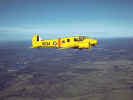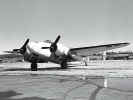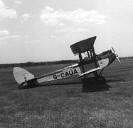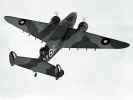

Fleet Fawn Tempest Fleet Finch Halifax
The History and the Aircraft of the Air Forces of Canada - from 1914 to today.
The Second World War : Part 3.
Anti-Submarine Warfare
Seven RCAF squadrons served with Coastal Command in Great Britain. 404, 407 and 415 were equipped with land planes. 413, 422 and 423 had flying boats and 162 flew the amphibious Canso.
404 spent most of the war in the Shetland Isles and Northern Scotland as a coastal fighter unit. 407 was the most successful strike squadron in Coastal Command during 1941 and 1942. It then converted to anti-submarine warfare and its crews scored four definite kills. 415 was very successful in night attacks over the North Sea and English Channel before joining Bomber Command in 1944.
422 and 423 Squadrons were continuously employed as convoy escorts and in anti-submarine warfare from Iceland to Gibraltar. They sent six submarines to the bottom. 162 Squadron also killed six U-Boats in the Battle of the Atlantic, five in less than a month.
One of these latter six was the result of actions by a crew captained by F/L D.E. Hornell. Despite one engine and the starboard wing on fire, Hornell's depth charges sank the U-Boat. But his Canso, blazing and holed, became highly unairworthy. One engine fell off into the sea. He ditched the aircraft and the crew of eight took turns huddling in the single dinghy for 21 hours. Two died of exposure. Hornell did much to keep the others alive until rescue arrived. By then he was completely exhausted and blind, and he died shortly after. For "valour and devotion to duty of the highest order" F/L Dave Hornell was awarded the Victoria Cross.
413 (Catalina) Squadron carried out coastal duties over the Indian Ocean. On one of their first patrols, S/L L.J. Birchall and his crew detected a Japanese invasion fleet approaching Ceylon. The Catalina was shot down, but its wireless operator's signals ensured the island's defences were ready and Birchall gained the title "Saviour of Ceylon ".
Air Transport Operations
437 Squadron towed gliders to the airborne landing at Arnhem in September of 1944. Its Dakotas dropped supplies and ferried troops, equipment, ammunition and fuel to the continent returning with casualties and VIPs. After the German surrender 437 moved to the continent and extended its operations to Oslo, Vienna, Naples and Athens.
The Dakotas of 435 and 436 Squadrons, in support of Fourteenth Army Operations in Burma, dropped supplies by parachute on tiny jungle drop-zones. These two squadrons were the last RCAF units in operations against the enemy as they flew until August of 1945 when the Japanese surrendered.


Fleet Fawn
Tempest
Fleet Finch
Halifax





DH Genet Moth
Avro Anson
Bolingbroke
Swordfish
Ventura Bermuda


![]() Waco PG 2A
Oxford
Brewster
Waco PG 2A
Oxford
Brewster
(J.McNulty photo)





Hurricane
Lodestar
Cornell
Cirrus Moth
Liberator
© Canada Aviation Museum





Tiger Moth
Lincoln
Prentice
Hudson
Albacore
For more information on the "Battle of the Atlantic" please
follow the link to: 422
Squadron. Then go to Second WW P 4.
![]()
![]()
![]()
![]()